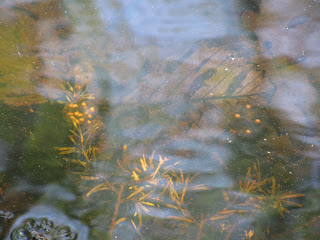Two rough-skinned newt egg masses above; 1 below. Look for the pearls.
I have been neglectful in my amphibian monitoring reporting. I will catch up on the findings and the wonder of the days here. We conducted monitoring on April 4th and again on April 24th. The 1st pond- 7 tree frog egg masses; 82 long-toed salamander egg masses; 2 northwestern salamander egg masses. 2nd site- 2 rough-skinned newt egg masses. The latest visit- 1st pond- 16 tree frog egg masses; few tadpoles; and at least 20 larval salamanders of unknown species. 2nd site- 71 rough-skinned newt egg masses! (This compared to our first visit in February- 1st site 104 tree frog egg masses/14 long-toed egg masses. 2nd site- nothing.) Photos of rough-skinned newt egg masses above are from our latest visit. They lay the eggs in a few inches of water attached to the leaves or twigs/branches under water. These masses can have 2 eggs or 20 and often are well-hidden. I chose to let my partner walk in the ponds alone.
This Monday was a warm gentle Pacific Northwest spring day. As I stand recording my field partners' findings, I also keep track of the birds and other goings-on around me. I watch black-capped chickadees excavate a cavity in a small snag and dark-eyed juncoes and a golden-crowned kinglet bathe in a tiny groundwater-fed stream across the pond. The soft thudding of a downy or hairy woodpecker in the background is heard between the din of traffic- lots and lots of traffic. This whole little natural world is adjacent to a busy arterial and surrounded by homes on large lots. All this life- amphibians, birds, flowering shrubs, snags, and small ephemeral streams going about their business while dump trucks and family cars speed on by, never realizing this little island oasis exists. I hear a flock of evening grosbeaks as we finish up our survey. In the time we were at this site I also saw crows nesting, and heard the songs of bewick's wren, song sparrow, and spotted towhees.
The small seasonal ponds at the second site are fed by a seasonal stream. This is a newly created wetland area so the shrubs are sticks with leaves. The ponds are found at the end of a dead end street just off another incredibly busy street. It's much quieter here and the area is surrounded by a mostly deciduous forest with scattered western hemlocks, Douglas-fir, and western redcedar. I catch the pungent aroma of skunk cabbage from nearby unseen wetlands. The scent mixes with that of the freshly-emerged leaves of black cottonwoods, red alder and a myriad of shrub species. One of these little ponds is full of rough-skinned newt egg masses. As I'm standing at the edge looking in I also spot what appear to be caddisflies carrying their spun home of needles and leaves all around them to protect their soft bodies. I wonder if they will survive the drying up of the pond as it becomes disconnected from the stream. The newts must know, otherwise would they lay their eggs here? We know tree frogs are around but their egg masses are not in our ponds. Maybe they know more than the newts. Keep checking back as this adventure continues once a month through August.
Chickadee nest










